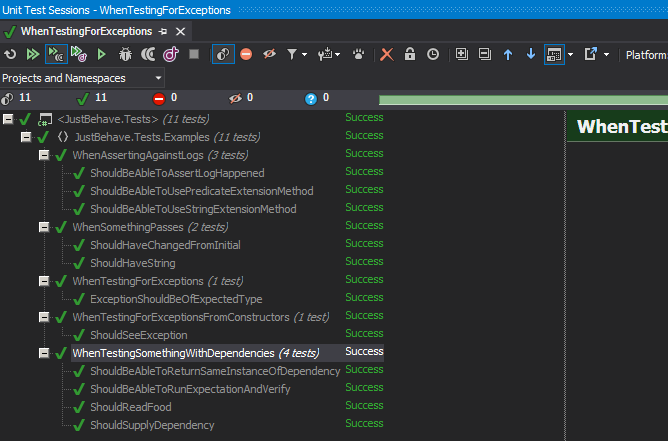A BDD-influenced C# testing library cooked up by JUST EAT
- Introduction
- Installation
- Getting Started
- Documentation
- Contributing
- Copyright
JustBehave is a small .NET library that helps you structure your C# tests into BDD-style contexts and scenarios. It supports both NUnit and XUnit and depends on AutoFixture for automatic dependency construction using your mocking framework of choice.
JustBehave was written to ensure that our internal tests followed a consistent and sane BDD pattern, without relying on frameworks like SpecFlow and the Gherkin language. Tests written using JustBehave are structured and organised, without requiring additional tooling or plugins.
Pre-requisites: The project is built in .net v4.0.
- From source: https://github.com/justeat/JustBehave
- By hand: https://www.nuget.org/packages/JustBehave
Via NuGet:
PM> Install-Package JustBehave
Once you have the package installed into your test project, along with your test framework of choice, a standard JustBehave test file will look like this using XUnit:
//public class TestClassNamedAfterABddContext : XBehaviourTest<TheClassThatIWantToTest> // XUnit
public class TestClassNamedAfterABddContext : BehaviourTest<TheClassThatIWantToTest> // NUnit
{
private string _input;
private string _result;
protected override void Given()
{
_input = "my input";
}
protected override void When()
{
_result = SystemUnderTest.CallingAMethod(_input);
}
[Then]
public void ReturnsSomething()
{
_result.ShouldBe("something");
}
}A full set of tested examples are provided in the repository in the project JustBehave.Tests in the Examples namespace.
- Important classes and attributes
- Structuring Contexts and Scenarios
- Handling and Testing Exceptions
- Testing classes with dependencies
The core of JustBehave is built upon a few small classes:
BehaviourTest- inherited for an NUnit testXBehaviourTest- inherited for an XUnit testThenAttribute- used to annotate your Then conditions for the nunit testing framework- when using xunit, use
FactAttributeas normal
- when using xunit, use
This leads to test classes that follow the convention:
public class TestClassNamedAfterABddContext : BehaviourTest<TheClassThatIWantToTest>
{
protected override void Given(){ /*...*/ }
protected override void When(){ /*...*/ }
[Then] public void Assertion1(){ /*...*/ }
[Then] public void Assertion2(){ /*...*/ }
}The NUnit TestFixtureAttribute is optional and implemented on the base of our NUnit BehaviourTest classes.
The core of JustBehave is a base class for your tests that enforces a "Given, When, Then" pattern. Each test file represents a single context with a Given, a When, and multiple Then assertions.
Broader tests are constructed by inheriting from previous test classes, and overriding the Given or When steps, while adding additional Then conditions to construct scenarios. Expect to use namespaces to group related scenarios, while giving your test classes names that represent their context.
For example, when testing some payment infrastructure, expect to end up with a set of files like this:
/Tests/Payments/WhenIMakeAPayment.cs
/Tests/Payments/AndMyPaymentIsRejected.cs (inherits from WhenIMakeAPayment.cs)
/Tests/Payments/AndMyPaymentIsAccepted.cs (inherits from WhenIMakeAPayment.cs)
By following this style, you'll end up with a ReSharper test runner that looks like this:
If you want to assert on thrown exceptions, you setup your Given() step like this:
protected override void Given()
{
RecordAnyExceptionsThrown();
}Any exceptions thrown will then be available in your Then steps for you to assert on:
[Then]
public void ShouldSeeException()
{
ThrownException.ShouldBeTypeOf<NotSupportedException>();
}In order for JustBehave to construct your dependency graphs, you must either:
- Manually construct your system under test
- Configure AutoFixture and a mocking framework to auto-mock your dependencies
To override construction of the system under test, you need to override CreateSystemUnderTest() and return a valid instance:
protected override SomethingUnderTest CreateSystemUnderTest()
{
return new SomethingUnderTest();
}Alternatively, to configure AutoFixture, you should override CustomizeAutoFixture() providing a valid AutoFixture customisation:
protected override void CustomizeAutoFixture(Fixture fixture)
{
fixture.Customize(new AutoRhinoMockCustomization());
// You can add more customisations by adding the NuGet packages for
// Ploeh.AutoFixture.Auto**PopularMockingFramework** and hooking them up
}If you find a bug, have a feature request or even want to contribute an enhancement or fix, please follow the contributing guidelines included in the repository.
Copyright 2011-2014 Just Eat, Inc. or its affiliates. All Rights Reserved.
Licensed under the Apache License, Version 2.0 (the "License"). You may not use this file except in compliance with the License. A copy of the License is located in the LICENSE file in this repository.
This file is distributed on an "AS IS" BASIS, WITHOUT WARRANTIES OR CONDITIONS OF ANY KIND, either express or implied. See the License for the specific language governing permissions and limitations under the License.

